Christensen Recognized as AAAS Fellow
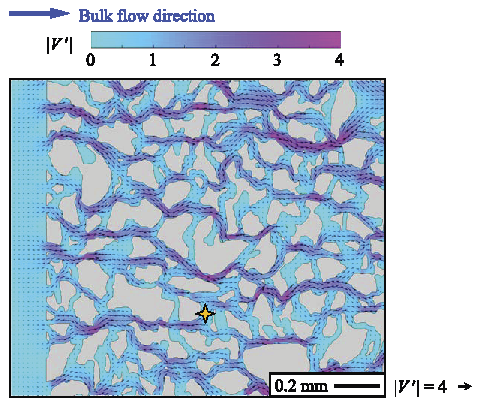 Averaged velocity field of the prefront-passage of CO2; contours reflect water velocity magnitude; gray regions represent solid grains; unless otherwise stated, only every other vector is shown in both the horizontal and vertical directions for clarity. Source: Li, Y., F. Kazemifar, G. Blois, and K. T. Christensen (2017), Micro-PIV measurements of multiphase flow of water and liquid CO2 in 2-D heterogeneous porous micromodels, Water Resour. Res., 53, 6178–6196, doi:10.1002/2017WR020850. Averaged velocity field of the prefront-passage of CO2; contours reflect water velocity magnitude; gray regions represent solid grains; unless otherwise stated, only every other vector is shown in both the horizontal and vertical directions for clarity. Source: Li, Y., F. Kazemifar, G. Blois, and K. T. Christensen (2017), Micro-PIV measurements of multiphase flow of water and liquid CO2 in 2-D heterogeneous porous micromodels, Water Resour. Res., 53, 6178–6196, doi:10.1002/2017WR020850.
|
Kenneth T. Christensen, Collegiate Professor of Fluid Mechanics and chair of the Department of Aerospace and Mechanical Engineering in the College of Engineering at the University of Notre Dame, has been selected as a 2017 Fellow of the American Association for the Advancement of Science (AAAS). Christensen was honored for his contributions to the field of experimental fluid mechanics, specifically laser-based measurements of turbulence interactions with complex topography.
Each year, members of AAAS choose 396 Fellows for their distinguished efforts to advance science and its applications. Christensen’s expertise includes an emphasis on flows central to a range of energy, environmental, and geophysical applications. His work has included multi-phase flow within heterogeneous porous media, with application to geologic carbon sequestration. Within the Pore-scale Pressure Transmission theme of GSCO2, he directs a research group that pursues laboratory studies of CO2 displacement of water in porous matrices replicated from those encountered in the Illinois Basin - Decatur Project. Because these experiments are conducted at reservoir-relevant conditions (pressure and temperature), they are the first to quantify the flow dynamics of CO2 in heterogeneous rock for improved modeling and upscaling of CO2 migration predictions. His group is presently studying how CO2 migration dynamics are related to pore-pressure events that may be linked to induced seismicity.
Christensen has also been honored as a Fellow of the American Physical Society and the American Society of Mechanical Engineers and as an Associate Fellow of the American Institute of Aeronautics and Astronautics. In addition, he serves as Editor-in-Chief of Measurement Science and Technology and on the Editorial Board of Experiments in Fluids.
New AAAS Fellows will be recognized for their contributions to science and technology at the Fellows Forum to be held on February 17, 2018, during the AAAS Annual Meeting in Austin, Texas. The full list of 2017 Fellows was published in the November 24 issue of Science.
Contact: Kenneth T. Christensen, christensen.33@nd.edu.
 |
GSCO2 Annual review meeting strengthens research efforts to understand microseismicity
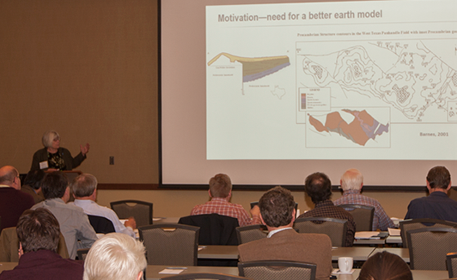 Dr. Melanie Barnes from Texas Tech University presents on characterization of crystalline basement rock during the Geology Theme technical session. Photo Credit: Jonathan Cox, Illinois State Geological Survey. Dr. Melanie Barnes from Texas Tech University presents on characterization of crystalline basement rock during the Geology Theme technical session. Photo Credit: Jonathan Cox, Illinois State Geological Survey. |
Eighty-seven members of the GSCO2 spent March 29–30 in Champaign, IL, engaged in discussions on how to better understand and predict the mechanisms controlling injection-induced microseismicity. Researchers shared their results and plans with 18 external advisory committee members, who offered advice on how to address basic science research needs for geologic carbon storage.
Principal investigators and senior researchers from the University of Illinois at Urbana-Champaign (UIUC), Illinois State Geological Survey, University of Texas-Austin, University of Southern California, NORSAR, and SINTEF presented on progress made during the past year in each theme. New principal investigators and senior researchers from Texas Tech University, Los Alamos National Laboratory, and UIUC presented on methods they will use in the Geology, Geomechanical Measurements, and Geochemical Reactions Themes. A Q&A; panel at the end of each theme’s technical session initiated impromptu conversations about scientific challenges.
Read More >
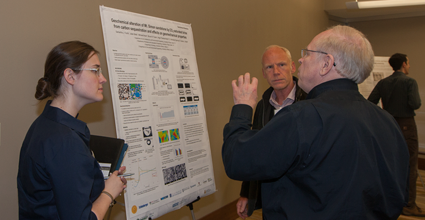 University of Texas-Austin graduate researcher Samantha Fuchs (left) discusses her research with University of Southern California principal investigator Dr. Kristian Jessen (right, background) and Science Advisory Council member Dr. Hannes Leetaru (right, foreground), a senior petroleum geologist at the Illinois State Geological Survey. Photo Credit: Jonathan Cox, Illinois State Geological Survey. University of Texas-Austin graduate researcher Samantha Fuchs (left) discusses her research with University of Southern California principal investigator Dr. Kristian Jessen (right, background) and Science Advisory Council member Dr. Hannes Leetaru (right, foreground), a senior petroleum geologist at the Illinois State Geological Survey. Photo Credit: Jonathan Cox, Illinois State Geological Survey. |
In a poster session at the end of the first day, graduate students and early career professionals discussed their research with senior researchers and members of the advisory committees representing basic science research and industry. Advisory committee members found the session to be a productive forum for engaging with young scientists. According to Cark Sisk, a member of the Industry Advisory Board, the poster session was the best interface the committees had with the group.
Students and early career professionals, like Samantha Fuchs, a PhD student from the University of Texas-Austin, found discussions with committee members to
be encouraging.
“Expanding into geochemical reactions from my previous research has been a challenge, but the poster session allowed me to share my current successes and failures with advisory board members who offered both compliments and advice on where to direct my research in the future,” Fuchs wrote after the meeting. “I have renewed confidence and new plans for my experiments.”
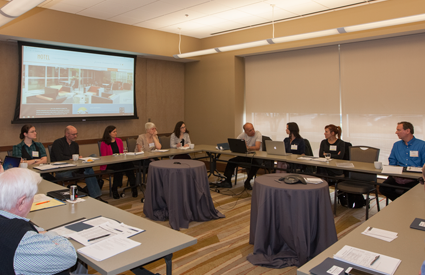 Cross-theme meeting on the second day between Geochemical Reactions and Microseismicity. Photo Credit: Jonathan Cox, Illinois State Geological Survey. Cross-theme meeting on the second day between Geochemical Reactions and Microseismicity. Photo Credit: Jonathan Cox, Illinois State Geological Survey. |
On the second day, research themes met separately and with each other to discuss on-going and future collaborations. The advisory committee members attended these meetings, which provided the opportunity for them to pose questions and offer advice during discussions. At the end of day, the advisory committees presented their comments to all themes.
Comments from the advisory committees highlighted areas of productive, fundamental scientific research within the Center. Cark Sisk complimented both the wettability and positron emission tomography work within the Geochemical Reactions Theme. Similarly, Industry Advisory Board member Bo Tye complimented the geochemical and pore-scale work, suggesting that Center researchers should “get the word out
to industry.”
 |
GSCO2 Collaborates with Stanford University on PET Training
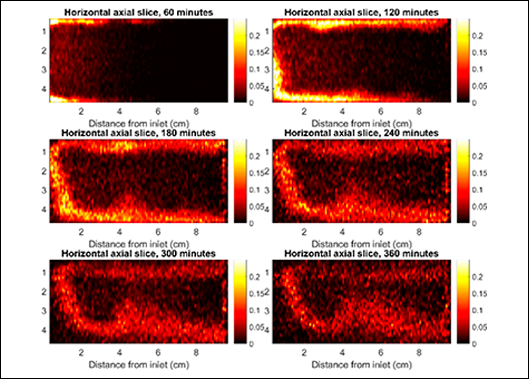 A Preliminary PET scan of Mt. Simon sandstone injected with a positron-emitting CO2-rich brine. Lighter colors indicate a higher concentration of the tracer and thus the injected fluid. These images are the first of their kind for Mt. Simon cores. Photo credit: Gabriela Dávila, University of Illinois at Urbana-Champaign. A Preliminary PET scan of Mt. Simon sandstone injected with a positron-emitting CO2-rich brine. Lighter colors indicate a higher concentration of the tracer and thus the injected fluid. These images are the first of their kind for Mt. Simon cores. Photo credit: Gabriela Dávila, University of Illinois at Urbana-Champaign.
|
Gabriela Dávila, a GSCO2 postdoctoral researcher at the University of Illinois at Urbana-Champaign, is using positron emission tomography (PET) scanning to measure and record a unique and novel data set, based on a collaboration between the GSCO2 and Stanford University. Positron emission tomography, although common in the medical sciences, is a new technique in the geological sciences that is expected to provide direct imaging of the interaction of CO2 with reservoir rock in real time using artificially labeled radioactive carbon atoms.
“My two-week stay in Stanford was very helpful not only to obtain preliminary PET scans but also to advance my understanding of the interaction between supercritical CO2 and the rock samples we are testing,” said Dávila. “The most important aspect of my time there was learning about the operation of the equipment so that I can construct the same experimental setup at the University of Illinois.”
Dávila and UIUC Professor Jennifer Druhan will quantify 1 mm3 voxel-scale permeability of rock samples that are representative of CO2 storage reservoirs. By scanning a rock sample injected with fluid containing a radioactive tracer, Dávila can quantify the velocity of the fluid in real time—and ultimately map the permeability of the sample at a resolution complementary to the representative elementary volume size employed for numerical models of coupled flow
and reactivity.
“Gaby is developing an entirely new approach to quantitatively image CO2-rock interactions in real time under through-flowing reservoir conditions. The data she produces will help us to elucidate the locations and temporal scales over which reactivity occurs and how these alterations influence the physical structure of reservoirs,” said Druhan.
In certain cases, chemical reactions between reservoir rock, CO2, and brine will weaken rocks, making the rock more susceptible to microseismicity. Visualizing these reactions provides insight into where reservoir rock may be weakened during and after injection and potentially how this weakening could impact a CO2 project. Advancing such knowledge of chemical reactions and microseismicity reduces the risk of commercial-scale CO2 storage.
 |
Chicago Tribune and Peoria Journal Star discuss meteorite impact structures with Charles Monson
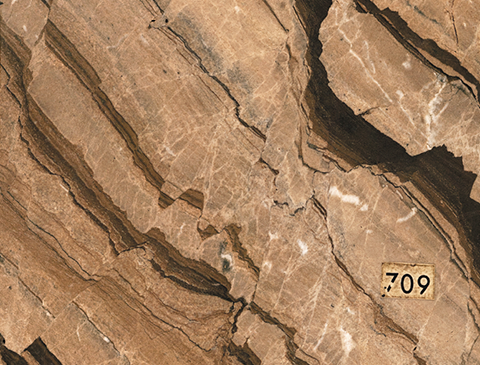 Photo Credit: Daniel Byers, Illinois State Geological Survey. Photo Credit: Daniel Byers, Illinois State Geological Survey.
|
The meteor sighting over the Midwest in February prompted the Chicago Tribune and Peoria Journal Star to speak with Charles Monson about two meteorite impact structures in Illinois, the Des Plaines Disturbance and the Glasford Structure. Impact structures may have far-field effects on large-scale carbon dioxide storage, such as causing geologic formations to be susceptible to microseismicity or breaching caprock.
Monson is a PhD student at the University of Illinois at Urbana-Champaign and an assistant project coordinator at the Illinois State Geological Survey. As a member of the Geology Theme, he is investigating the relationship of sedimentary architecture and the paleoenvironment to geomechanical properties.
Contact:
cmonson@illinois.edu
Charles Werth Gives Plenary Talk at US DOE Basic Research Needs Workshop
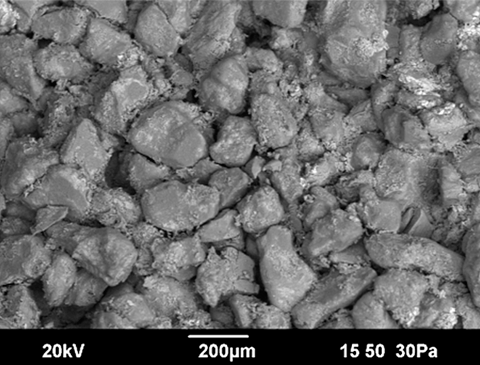 Photo Credit: Samantha Fuchs and Charles Werth, UTA. Photo Credit: Samantha Fuchs and Charles Werth, UTA. |
The US Department of Energy (DOE), Office of Science, sponsored a basic research needs workshop where scientists representing universities, national research laboratories, and private companies charted future basic research needs in the energy-water nexus. Basic research needs workshops assist the Office of Science in shaping priority research directions, which are usually detailed in a workshop report. According to DOE, these reports “address the status of some important research areas that are used to help identify research directions for a decades-to-century energy strategy.”
The DOE, Office of Science, invited Professor Charles Werth, leader of the Geochemistry Theme, to give a plenary talk at the workshop. Werth identified
challenges in the energy-water nexus for subsurface extraction and storage. He also discussed different basic research approaches for addressing those challenges, including approaches being used
in the GSCO2.
The basic research needs workshop was held in Bethesda, Maryland, on January 4–6, 2017.
 |
Issue 3 of GSCO2's Newsletter, GSCO2 in Focus, is Now Available
 This issue of the GSCO2 in Focus highlights advances in imaging CO2-rock interactions, research published in a special issue of the Journal of Petroleum Science and Engineering, an innovative mechanical test on a cubic meter block of sandstone, and more. You can download issue 3 of the Newsletter by clicking on the image left or here.
This issue of the GSCO2 in Focus highlights advances in imaging CO2-rock interactions, research published in a special issue of the Journal of Petroleum Science and Engineering, an innovative mechanical test on a cubic meter block of sandstone, and more. You can download issue 3 of the Newsletter by clicking on the image left or here.
CO2 Injection-induced Microseismicity Focus
Our research focus is on a single overarching research question:
What are the mechanisms of injection-induced microseismicity, and can we control and predict its occurrence?
To address this question, the GSCO2 has five themes, each with a specific research question:
Microseismicity Theme:
- How can we unravel the links between induced microseismicity and the stress field?
Reservoir-scale Geology Theme:
- How do reservoir-scale geologic features relate to geomechanical and seismic properties
of rocks?
Geomechanical Measurements Theme:
- How can measurements of geomechanical properties at pore and core scales be improved?
Pore-scale Pressure Transmission Theme:
- How do pore fluid pressure fluctuations transmit in, and affect the state of, realistic porous and fractured media?
Geochemical Reactions Theme:
- How do pore fluid pressure fluctuations transmit in, and affect the state of, realistic porous and fractured media?
Issue 1 of GSCO2's Newsletter, GSCO2 in Focus, is Now Available
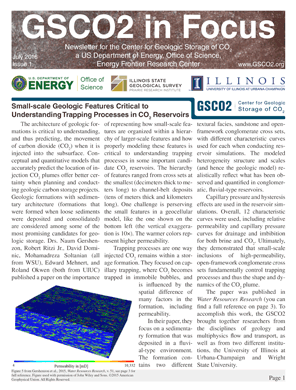 This issue highlights research publications and progress, the Center’s 2016 Annual Review Meeting, and the Center’s members and advisors.
You can find a copy on the
This issue highlights research publications and progress, the Center’s 2016 Annual Review Meeting, and the Center’s members and advisors.
You can find a copy on the
Newsletter page or download a copy by clicking Here.
GSCO2 hosts 2016 Annual Review Meeting
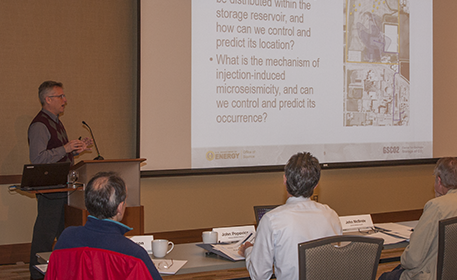 The Center for Geologic Storage of CO2 (GSCO2) hosted its annual review meeting in Champaign, IL, on March 30–31. The meeting had sixty-four attendees, including 17 external advisory committee members, 20 principal investigators and senior personnel, and 19 students and early career professionals. Members of the Center’s two external advisory committees, the Center Science Advisory Council and Center Industry Advisory Board, also attended. The meeting provided a forum to receive input from the advisory committees on research progress and directions, as well as to share research progress, accomplishments, and directions across the Center’s four themes.
The Center for Geologic Storage of CO2 (GSCO2) hosted its annual review meeting in Champaign, IL, on March 30–31. The meeting had sixty-four attendees, including 17 external advisory committee members, 20 principal investigators and senior personnel, and 19 students and early career professionals. Members of the Center’s two external advisory committees, the Center Science Advisory Council and Center Industry Advisory Board, also attended. The meeting provided a forum to receive input from the advisory committees on research progress and directions, as well as to share research progress, accomplishments, and directions across the Center’s four themes.
The first day featured technical presentations by principal investigators from the University of Illinois at Urbana-Champaign (UIUC), Illinois State Geological Survey (ISGS), University of Notre Dame, University of Texas-Austin (UTA), University Southern California (USC), Wright State University (WSU), NORSAR, SINTEF, Schlumberger (SLB), and the National Energy Technology Laboratory (NETL; see the bottom of the page for the full agenda). Theme Coordinators gave overview presentations that detailed how research activities contributed to basic science and the GSCO2’s two fundamental questions.
Read More >
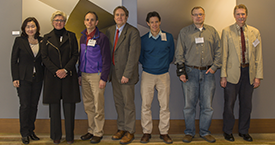
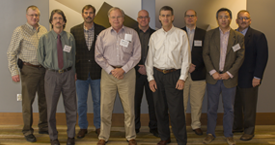
Photo Far Left: Center Science Advisory Council members who attended the annual meeting (from left to right): Young Shin Jun, Dorthe Wildenschild, Thomas Johnson, William Harbert, John Popovics, Alexey Bezryadin, and John McBride. George Guthrie attended the meeting but was not present for the picture.
Photo Right: Center Industry Advisory Board members who attended the annual meeting (from left to right): Tom Davis, Robert (Bo) Tye, Richard Esposito, Charles Christopher, Shawn Maxwell, Carl Sisk, George Koperna, Yongqi Lu, and Albert Giussani. Photo Credit: Jonathan Cox, Illinois State Geological Survey.
Following the technical presentations, GSCO2 students, post-docs, and early career professionals highlighted their research in a poster session, which encouraged discussion between young scientists (graduate students, post-doctoral students, and early career professionals), senior researchers, and members of the advisory committees. Topics of the posters ranged from molecules, such as a study on clay swelling and adsorption of CO2 using molecular dynamics simulation presented by Hassan Dashtian (USC, PhD student), to pores, such as a study on the direct measurement of CO2 and brine in sandstone pores at reservoir pressure presented by John Tudek (NETL, PhD student), to geologic features, such as a study on using structure-from-motion photogrammetry to quantify sedimentary heterogeneity presented by Ruisong Zhou (UIUC, PhD student).
Posters also showcased collaborations within and between themes. Charles Monson (UIUC, PhD student) presented a poster on stratigraphic and petrological properties of the Cambrian Argenta Formation, and how geologic properties may control microseismicity. Co-authors on the poster included Jared Freiburg (ISGS, assistant geologist; PhD student, Institute for Geography and Geology in Greifswald, Germany), Dr. Arjan Reesink (UIUC, early career professional), Dr. Robert Ritzi (WSU), and Dr. Volker Oye (NORSAR). Dr. Alexander Klokov (UTA, early career professional) presented a poster on seismic imaging, including correlating seismic images with microseismic events, which connects the work of the Geophysics and Geomechanics themes. Dr. Bob Hardage (UTA) was a co-author.
On the second day, cross-theme and individual working meetings were held. Cross-theme meetings provided face-to-face interactions to discuss on-going challenges in GSCO2 research across themes and between partner institutions. Scientific discussions during the cross-theme meetings enabled researchers to improve current collaborative efforts and develop new collaborative ideas, such as research methods or directions. Individual theme meetings provided time for themes to synthesize their discussions from the morning and identify action items for after the review meeting. Members of the advisory committees joined the working meetings to give input on the challenges facing each theme and to hear directly about the future direction of each theme’s research. At the conclusion of the day, the advisory committees reported their observations and comments to all themes. After engaging GSCO2 principal investigators, senior personnel, and young scientists during the two-day review meeting, members of the advisory committees commented that the GSCO2 made substantial progress from its meeting last year. The Center intends to capitalize on that progress over the course of the next year.
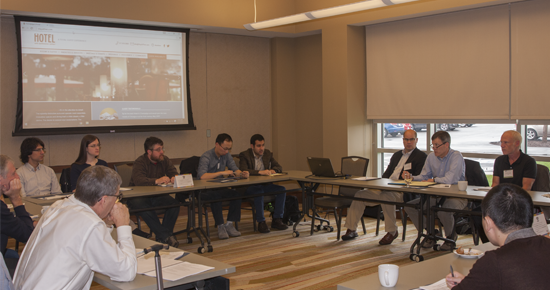
Photo Left: Multiphysics Flow and Transport Theme members discussing research activities during one of the theme breakout sessions on the second day of the meeting. Photo Credit: Jonathan Cox, Illinois State Geological Survey.

Download Full Agenda PDF
 |
Wright State News Room Highlights Center for Geologic Storage of CO2 Research
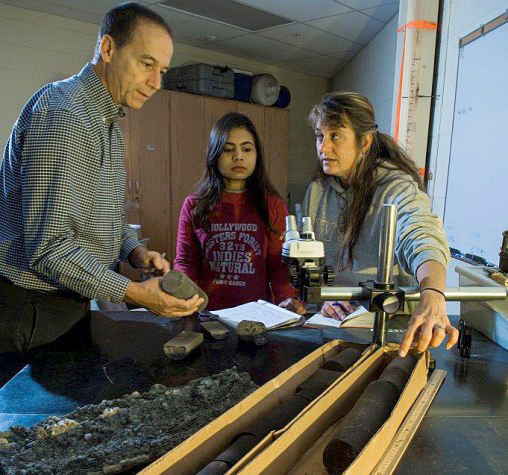 GSCO2 researchers at Wright State University discussed the Center’s research and importance with Jim Hannah of the Wright State University News Room.
GSCO2 researchers at Wright State University discussed the Center’s research and importance with Jim Hannah of the Wright State University News Room.
Source: Wright State University News Room
Photo Credit: Erin Pence
GSCO2 Research Featured in Frontiers in Energy Research
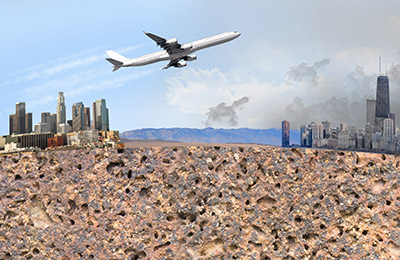 The Winter 2015 issue of Frontiers in Energy Research featured Center for Geologic Storage of CO2 (GSCO2) research in an article titled “Storms Are the Norm, Underground.” The article discusses efforts made by the three carbon storage Energy Frontier Research Centers to understand the effects of geochemical processes on subsurface fluid flow. Albert J. Valocchi, Abel Bliss Professor of Engineering at the University of Illinois at Urbana-Champaign and GSCO2 Multiphysics Flow and Transport Theme member, contributed the GSCO2 research featured.
The Winter 2015 issue of Frontiers in Energy Research featured Center for Geologic Storage of CO2 (GSCO2) research in an article titled “Storms Are the Norm, Underground.” The article discusses efforts made by the three carbon storage Energy Frontier Research Centers to understand the effects of geochemical processes on subsurface fluid flow. Albert J. Valocchi, Abel Bliss Professor of Engineering at the University of Illinois at Urbana-Champaign and GSCO2 Multiphysics Flow and Transport Theme member, contributed the GSCO2 research featured.
Source: US Department of Energy
Photo Credit: Pacific Northwest National Laboratory
Muhammad Sahimi Selected for InterPore’s 2015 Honorary Membership Award
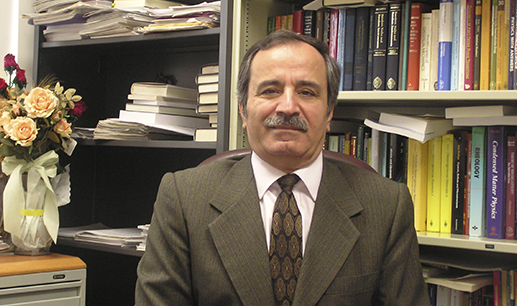 The International Society for Porous Media (InterPore) awarded Muhammad Sahimi their Honorary Membership Award for 2015. According to InterPore, the award is given to individuals who have made exceptional contributions to the field of porous media science and technology, are world renowned in the field, and have made contributions consistent with the aims and ideals of InterPore, and Dr. Sahimi was chosen for the award based on his “groundbreaking contributions to scientific knowledge on porous media.” The award, which is the highest one the society gives, included a certificate, lifetime InterPore membership, and travel grant of €1,000 to participate in the InterPore Annual Meeting and Conference. The award ceremony took place at the 7th International Conference on Porous Media and Annual Meeting, which was held on May 18th through the 21st in Padova, Italy.
The International Society for Porous Media (InterPore) awarded Muhammad Sahimi their Honorary Membership Award for 2015. According to InterPore, the award is given to individuals who have made exceptional contributions to the field of porous media science and technology, are world renowned in the field, and have made contributions consistent with the aims and ideals of InterPore, and Dr. Sahimi was chosen for the award based on his “groundbreaking contributions to scientific knowledge on porous media.” The award, which is the highest one the society gives, included a certificate, lifetime InterPore membership, and travel grant of €1,000 to participate in the InterPore Annual Meeting and Conference. The award ceremony took place at the 7th International Conference on Porous Media and Annual Meeting, which was held on May 18th through the 21st in Padova, Italy.
Dr. Sahimi, who is a professor of chemical engineering and materials science and the NIOC Chair in petroleum engineering at the University of Southern California, is a member of the Multiphysics Flow and Transport Theme within the Center for Geologic Storage of CO2. His research within the Center includes molecular dynamics modeling of carbon dioxide (CO2) adsorption on selected minerals as part an effort to develop numerical models that can better understand and predict CO2 behavior at the molecular scale. This work will be combined with other Multiphysics Theme work at the pore and core scales to better predict the location and distribution of injected CO2 within a storage reservoir.
More information about the award can be found on the Prizes and Awards 2015 page of the InterPore website.
Contact: Muhammad Sahimi, moe@usc.edu
 |
Hardage Presents Webinar on Advances in Shear Wave Reflection Seismology
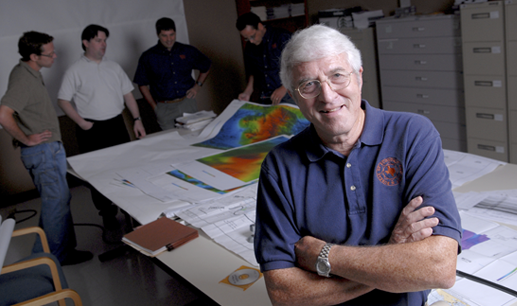 Bob A. Hardage presented four half-day sessions describing a methodology to extract shear (S) wave images from compressional (P) wave sources, as part of a live webinar presented by the Geophysical Society of Houston and Society of Exploration Geophysicists. Hardage’s sessions on the first and second days compared S-wave and P-wave modeling, demonstrating why S-wave imaging is just as crucial as P-wave imaging when characterizing a geologic formation, and how these wave images can be obtained from vertical seismic profile (VSP) data. The sessions on the third and fourth days detailed the methodology and illustrated its use via case histories, such as characterizing the Wolfberry unconventional reservoir system, Mt. Simon Sandstone, and Ellenberger carbonate. Hardage, a senior research scientist at the Bureau of Economic Geology, University of Texas at Austin, is the Geophysics Theme Leader for the Center for Geologic Storage of CO2 (GSCO2).
Bob A. Hardage presented four half-day sessions describing a methodology to extract shear (S) wave images from compressional (P) wave sources, as part of a live webinar presented by the Geophysical Society of Houston and Society of Exploration Geophysicists. Hardage’s sessions on the first and second days compared S-wave and P-wave modeling, demonstrating why S-wave imaging is just as crucial as P-wave imaging when characterizing a geologic formation, and how these wave images can be obtained from vertical seismic profile (VSP) data. The sessions on the third and fourth days detailed the methodology and illustrated its use via case histories, such as characterizing the Wolfberry unconventional reservoir system, Mt. Simon Sandstone, and Ellenberger carbonate. Hardage, a senior research scientist at the Bureau of Economic Geology, University of Texas at Austin, is the Geophysics Theme Leader for the Center for Geologic Storage of CO2 (GSCO2).
Investigating the ability to extract S-waves from P-waves, along with investigating all converted wave modes, is a central part of the Geophysics research within the GSCO2. Specifically, GSCO2 Geophysics research seeks to improve the ability to image geologic formations with three-dimensional (3D) VSP data and surface-based 3D data to better predict the location and distribution of carbon dioxide (CO2) injected into geologic formations for storage. Geophysics research also seeks to improve the ability to identify CO2 injected into the subsurface using
these seismic data.
Imaging site-specific geology with both P and S seismic waves “[enhances] the prediction of rock and fluid properties” of geologic formations under consideration for CO2 storage, one of the primary scientific impacts identified by the United States Department of Energy in its 2007 publication titled Basic Research Needs for Geosciences: Facilitating 21st Century Energy Systems. Moreover, the methodology presented by Hardage lowers the cost and simplifies the acquisition of both P-waves and S-waves by utilizing only P-wave sources, and it reduces the costs for characterizing site-specific geology during CO2 storage and other subsurface projects. Research efforts such as this demonstrate how improving methodologies via a basic-science approach can ultimately lead to improved industry uses.
Contact: Bob A. Hardage, bob.hardage@beg.utexas.edu
Photo credit: Jackson School of Geosciences, University of Texas at Austin.
 |
Mehnert and Frailey Discuss the Importance of the GSCO2 and its Research with Inside Illinois
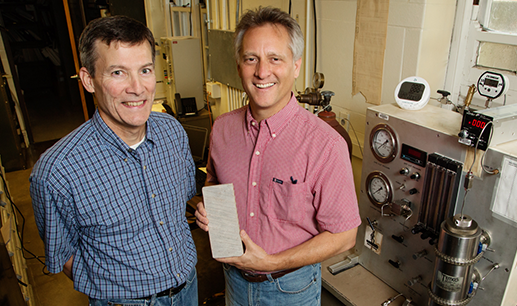 Edward Mehnert, a senior hydrologist at the Illinois State Geological Survey (ISGS) and multiphysics flow and transport theme coordinator, and Scott Frailey, a senior reservoir engineer at the ISGS and Center for Geologic Storage of CO2 Director, discussed the Center and its research with Inside Illinois.
Edward Mehnert, a senior hydrologist at the Illinois State Geological Survey (ISGS) and multiphysics flow and transport theme coordinator, and Scott Frailey, a senior reservoir engineer at the ISGS and Center for Geologic Storage of CO2 Director, discussed the Center and its research with Inside Illinois.
Source: Inside Illinois
Photo credit: L. Brian Stauffer
Jim Best Named American Geophysical Union 2015 Fellow
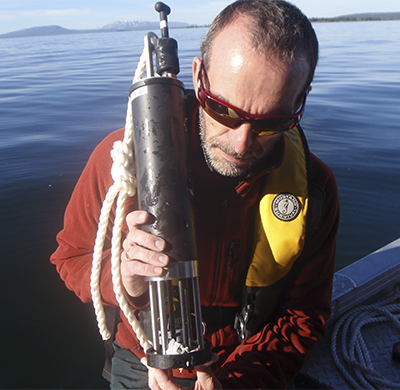 Jim Best was named a 2015 Fellow by the American Geophysical Union (AGU). According to the AGU, its Fellows program, which was established in 1962, recognizes “AGU members who have made exceptional scientific contributions and attained acknowledged eminence in the fields of Earth and space sciences.” He was nominated by the AGU Earth and Planetary Surface Processes section. Best, the Jack and Richard Threet Chair in Sedimentary Geology at the University of Illinois at Urbana-Champaign, is a member of the Center for Geologic Storage of CO2’s (GSCO2’s) Geology: Characterization and Geocellular Modeling theme.
As a geologist in the GSCO2, Best focuses on the sedimentology of clastic reservoirs. His efforts characterize the sedimentological architecture and heterogeneity of the Mt. Simon Sandstone and other analogous formations, at a range of scales from pore to basin, in order to develop more accurate geologic models across scales. As part of his study of natural analogues, Best collaborates with the geocellular modeling group and Multiphysics Flow and Transport theme. He also advises two postdoctoral fellows and two PhD students within the Geology theme.
Best has contributed to the areas of process sedimentology and geomorphology by studying modern and ancient sedimentary environments and investigating the coupling between fluid flow, sediment transport, and morphological development using laboratory, experimental, numerical, and field-based approaches. His work ranges across scales, including the study of turbulence modulation in fluid flows; the morphodynamics of bedform development; the dynamics and deposits of some of the World’s largest rivers (including the Jamuna, Parana, Mekong, Amazon, Mississippi, and Columbia Rivers), with an emphasis on multichannel braided rivers; sediment-laden density flows in the laboratory; contemporary glacial lakes and ancient deep-sea deposits; basin analysis of Carboniferous clastic sediments; and deltaic processes, form, and deposits.
The 2015 Fellows will be honored at a ceremony held during the AGU Fall Meeting in San Francisco this December.
Jim Best was named a 2015 Fellow by the American Geophysical Union (AGU). According to the AGU, its Fellows program, which was established in 1962, recognizes “AGU members who have made exceptional scientific contributions and attained acknowledged eminence in the fields of Earth and space sciences.” He was nominated by the AGU Earth and Planetary Surface Processes section. Best, the Jack and Richard Threet Chair in Sedimentary Geology at the University of Illinois at Urbana-Champaign, is a member of the Center for Geologic Storage of CO2’s (GSCO2’s) Geology: Characterization and Geocellular Modeling theme.
As a geologist in the GSCO2, Best focuses on the sedimentology of clastic reservoirs. His efforts characterize the sedimentological architecture and heterogeneity of the Mt. Simon Sandstone and other analogous formations, at a range of scales from pore to basin, in order to develop more accurate geologic models across scales. As part of his study of natural analogues, Best collaborates with the geocellular modeling group and Multiphysics Flow and Transport theme. He also advises two postdoctoral fellows and two PhD students within the Geology theme.
Best has contributed to the areas of process sedimentology and geomorphology by studying modern and ancient sedimentary environments and investigating the coupling between fluid flow, sediment transport, and morphological development using laboratory, experimental, numerical, and field-based approaches. His work ranges across scales, including the study of turbulence modulation in fluid flows; the morphodynamics of bedform development; the dynamics and deposits of some of the World’s largest rivers (including the Jamuna, Parana, Mekong, Amazon, Mississippi, and Columbia Rivers), with an emphasis on multichannel braided rivers; sediment-laden density flows in the laboratory; contemporary glacial lakes and ancient deep-sea deposits; basin analysis of Carboniferous clastic sediments; and deltaic processes, form, and deposits.
The 2015 Fellows will be honored at a ceremony held during the AGU Fall Meeting in San Francisco this December.
Contact: Jim Best, jimbest@illinois.edu
 |
Berg and Frailey Advocate for Energy Frontier Research Centers in Congressional Briefing
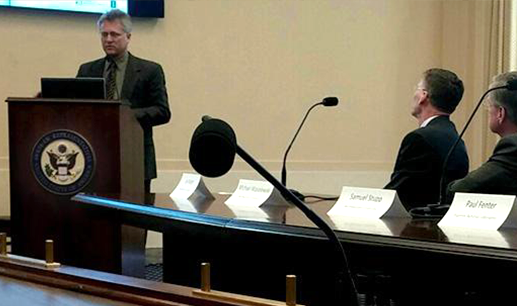 Scott Frailey, Director of the Center for Geologic Storage of CO2 and senior reservoir engineer at the Illinois State Geological Survey (ISGS), and Richard Berg, Director of the ISGS, participated in a Congressional briefing in Washington, DC, on the Energy Frontier Research Center program in Illinois.
Scott Frailey, Director of the Center for Geologic Storage of CO2 and senior reservoir engineer at the Illinois State Geological Survey (ISGS), and Richard Berg, Director of the ISGS, participated in a Congressional briefing in Washington, DC, on the Energy Frontier Research Center program in Illinois.
Source: Illinois State Geological Survey

 Averaged velocity field of the prefront-passage of CO2; contours reflect water velocity magnitude; gray regions represent solid grains; unless otherwise stated, only every other vector is shown in both the horizontal and vertical directions for clarity. Source: Li, Y., F. Kazemifar, G. Blois, and K. T. Christensen (2017), Micro-PIV measurements of multiphase flow of water and liquid CO2 in 2-D heterogeneous porous micromodels, Water Resour. Res., 53, 6178–6196, doi:10.1002/2017WR020850.
Averaged velocity field of the prefront-passage of CO2; contours reflect water velocity magnitude; gray regions represent solid grains; unless otherwise stated, only every other vector is shown in both the horizontal and vertical directions for clarity. Source: Li, Y., F. Kazemifar, G. Blois, and K. T. Christensen (2017), Micro-PIV measurements of multiphase flow of water and liquid CO2 in 2-D heterogeneous porous micromodels, Water Resour. Res., 53, 6178–6196, doi:10.1002/2017WR020850.
 Dr. Melanie Barnes from Texas Tech University presents on characterization of crystalline basement rock during the Geology Theme technical session. Photo Credit: Jonathan Cox, Illinois State Geological Survey.
Dr. Melanie Barnes from Texas Tech University presents on characterization of crystalline basement rock during the Geology Theme technical session. Photo Credit: Jonathan Cox, Illinois State Geological Survey.
 A Preliminary PET scan of Mt. Simon sandstone injected with a positron-emitting CO2-rich brine. Lighter colors indicate a higher concentration of the tracer and thus the injected fluid. These images are the first of their kind for Mt. Simon cores. Photo credit: Gabriela Dávila, University of Illinois at Urbana-Champaign.
A Preliminary PET scan of Mt. Simon sandstone injected with a positron-emitting CO2-rich brine. Lighter colors indicate a higher concentration of the tracer and thus the injected fluid. These images are the first of their kind for Mt. Simon cores. Photo credit: Gabriela Dávila, University of Illinois at Urbana-Champaign.
 Photo Credit: Daniel Byers, Illinois State Geological Survey.
Photo Credit: Daniel Byers, Illinois State Geological Survey.

 Photo Credit: Samantha Fuchs and Charles Werth, UTA.
Photo Credit: Samantha Fuchs and Charles Werth, UTA.
 This issue of the GSCO2 in Focus highlights advances in imaging CO2-rock interactions, research published in a special issue of the Journal of Petroleum Science and Engineering, an innovative mechanical test on a cubic meter block of sandstone, and more. You can download issue 3 of the Newsletter by clicking on the image left or here.
This issue of the GSCO2 in Focus highlights advances in imaging CO2-rock interactions, research published in a special issue of the Journal of Petroleum Science and Engineering, an innovative mechanical test on a cubic meter block of sandstone, and more. You can download issue 3 of the Newsletter by clicking on the image left or here.
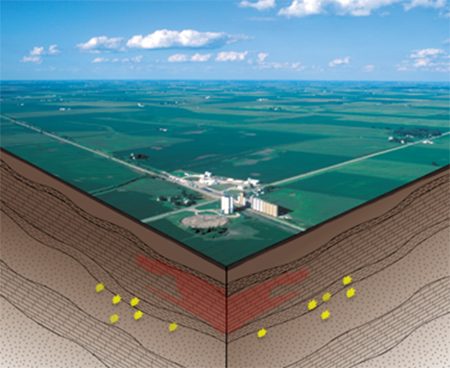

 This issue highlights research publications and progress, the Center’s 2016 Annual Review Meeting, and the Center’s members and advisors.
You can find a copy on the
This issue highlights research publications and progress, the Center’s 2016 Annual Review Meeting, and the Center’s members and advisors.
You can find a copy on the 
 The Center for Geologic Storage of CO2 (GSCO2) hosted its annual review meeting in Champaign, IL, on March 30–31. The meeting had sixty-four attendees, including 17 external advisory committee members, 20 principal investigators and senior personnel, and 19 students and early career professionals. Members of the Center’s two external advisory committees, the Center Science Advisory Council and Center Industry Advisory Board, also attended. The meeting provided a forum to receive input from the advisory committees on research progress and directions, as well as to share research progress, accomplishments, and directions across the Center’s four themes.
The Center for Geologic Storage of CO2 (GSCO2) hosted its annual review meeting in Champaign, IL, on March 30–31. The meeting had sixty-four attendees, including 17 external advisory committee members, 20 principal investigators and senior personnel, and 19 students and early career professionals. Members of the Center’s two external advisory committees, the Center Science Advisory Council and Center Industry Advisory Board, also attended. The meeting provided a forum to receive input from the advisory committees on research progress and directions, as well as to share research progress, accomplishments, and directions across the Center’s four themes.
 GSCO2 researchers at Wright State University discussed the Center’s research and importance with Jim Hannah of the Wright State University News Room.
GSCO2 researchers at Wright State University discussed the Center’s research and importance with Jim Hannah of the Wright State University News Room.

 The Winter 2015 issue of Frontiers in Energy Research featured Center for Geologic Storage of CO2 (GSCO2) research in an article titled “Storms Are the Norm, Underground.” The article discusses efforts made by the three carbon storage Energy Frontier Research Centers to understand the effects of geochemical processes on subsurface fluid flow. Albert J. Valocchi, Abel Bliss Professor of Engineering at the University of Illinois at Urbana-Champaign and GSCO2 Multiphysics Flow and Transport Theme member, contributed the GSCO2 research featured.
The Winter 2015 issue of Frontiers in Energy Research featured Center for Geologic Storage of CO2 (GSCO2) research in an article titled “Storms Are the Norm, Underground.” The article discusses efforts made by the three carbon storage Energy Frontier Research Centers to understand the effects of geochemical processes on subsurface fluid flow. Albert J. Valocchi, Abel Bliss Professor of Engineering at the University of Illinois at Urbana-Champaign and GSCO2 Multiphysics Flow and Transport Theme member, contributed the GSCO2 research featured. 
 The International Society for Porous Media (InterPore) awarded Muhammad Sahimi their Honorary Membership Award for 2015. According to InterPore, the award is given to individuals who have made exceptional contributions to the field of porous media science and technology, are world renowned in the field, and have made contributions consistent with the aims and ideals of InterPore, and Dr. Sahimi was chosen for the award based on his “groundbreaking contributions to scientific knowledge on porous media.” The award, which is the highest one the society gives, included a certificate, lifetime InterPore membership, and travel grant of €1,000 to participate in the InterPore Annual Meeting and Conference. The award ceremony took place at the 7th International Conference on Porous Media and Annual Meeting, which was held on May 18th through the 21st in Padova, Italy.
The International Society for Porous Media (InterPore) awarded Muhammad Sahimi their Honorary Membership Award for 2015. According to InterPore, the award is given to individuals who have made exceptional contributions to the field of porous media science and technology, are world renowned in the field, and have made contributions consistent with the aims and ideals of InterPore, and Dr. Sahimi was chosen for the award based on his “groundbreaking contributions to scientific knowledge on porous media.” The award, which is the highest one the society gives, included a certificate, lifetime InterPore membership, and travel grant of €1,000 to participate in the InterPore Annual Meeting and Conference. The award ceremony took place at the 7th International Conference on Porous Media and Annual Meeting, which was held on May 18th through the 21st in Padova, Italy. 
 Bob A. Hardage presented four half-day sessions describing a methodology to extract shear (S) wave images from compressional (P) wave sources, as part of a live webinar presented by the Geophysical Society of Houston and Society of Exploration Geophysicists. Hardage’s sessions on the first and second days compared S-wave and P-wave modeling, demonstrating why S-wave imaging is just as crucial as P-wave imaging when characterizing a geologic formation, and how these wave images can be obtained from vertical seismic profile (VSP) data. The sessions on the third and fourth days detailed the methodology and illustrated its use via case histories, such as characterizing the Wolfberry unconventional reservoir system, Mt. Simon Sandstone, and Ellenberger carbonate. Hardage, a senior research scientist at the Bureau of Economic Geology, University of Texas at Austin, is the Geophysics Theme Leader for the Center for Geologic Storage of CO2 (GSCO2).
Bob A. Hardage presented four half-day sessions describing a methodology to extract shear (S) wave images from compressional (P) wave sources, as part of a live webinar presented by the Geophysical Society of Houston and Society of Exploration Geophysicists. Hardage’s sessions on the first and second days compared S-wave and P-wave modeling, demonstrating why S-wave imaging is just as crucial as P-wave imaging when characterizing a geologic formation, and how these wave images can be obtained from vertical seismic profile (VSP) data. The sessions on the third and fourth days detailed the methodology and illustrated its use via case histories, such as characterizing the Wolfberry unconventional reservoir system, Mt. Simon Sandstone, and Ellenberger carbonate. Hardage, a senior research scientist at the Bureau of Economic Geology, University of Texas at Austin, is the Geophysics Theme Leader for the Center for Geologic Storage of CO2 (GSCO2).

 Edward Mehnert, a senior hydrologist at the Illinois State Geological Survey (ISGS) and multiphysics flow and transport theme coordinator, and Scott Frailey, a senior reservoir engineer at the ISGS and Center for Geologic Storage of CO2 Director, discussed the Center and its research with Inside Illinois.
Edward Mehnert, a senior hydrologist at the Illinois State Geological Survey (ISGS) and multiphysics flow and transport theme coordinator, and Scott Frailey, a senior reservoir engineer at the ISGS and Center for Geologic Storage of CO2 Director, discussed the Center and its research with Inside Illinois.

 Jim Best was named a 2015 Fellow by the American Geophysical Union (AGU). According to the AGU, its Fellows program, which was established in 1962, recognizes “AGU members who have made exceptional scientific contributions and attained acknowledged eminence in the fields of Earth and space sciences.” He was nominated by the AGU Earth and Planetary Surface Processes section. Best, the Jack and Richard Threet Chair in Sedimentary Geology at the University of Illinois at Urbana-Champaign, is a member of the Center for Geologic Storage of CO2’s (GSCO2’s) Geology: Characterization and Geocellular Modeling theme.
As a geologist in the GSCO2, Best focuses on the sedimentology of clastic reservoirs. His efforts characterize the sedimentological architecture and heterogeneity of the Mt. Simon Sandstone and other analogous formations, at a range of scales from pore to basin, in order to develop more accurate geologic models across scales. As part of his study of natural analogues, Best collaborates with the geocellular modeling group and Multiphysics Flow and Transport theme. He also advises two postdoctoral fellows and two PhD students within the Geology theme.
Best has contributed to the areas of process sedimentology and geomorphology by studying modern and ancient sedimentary environments and investigating the coupling between fluid flow, sediment transport, and morphological development using laboratory, experimental, numerical, and field-based approaches. His work ranges across scales, including the study of turbulence modulation in fluid flows; the morphodynamics of bedform development; the dynamics and deposits of some of the World’s largest rivers (including the Jamuna, Parana, Mekong, Amazon, Mississippi, and Columbia Rivers), with an emphasis on multichannel braided rivers; sediment-laden density flows in the laboratory; contemporary glacial lakes and ancient deep-sea deposits; basin analysis of Carboniferous clastic sediments; and deltaic processes, form, and deposits.
The 2015 Fellows will be honored at a ceremony held during the AGU Fall Meeting in San Francisco this December.
Jim Best was named a 2015 Fellow by the American Geophysical Union (AGU). According to the AGU, its Fellows program, which was established in 1962, recognizes “AGU members who have made exceptional scientific contributions and attained acknowledged eminence in the fields of Earth and space sciences.” He was nominated by the AGU Earth and Planetary Surface Processes section. Best, the Jack and Richard Threet Chair in Sedimentary Geology at the University of Illinois at Urbana-Champaign, is a member of the Center for Geologic Storage of CO2’s (GSCO2’s) Geology: Characterization and Geocellular Modeling theme.
As a geologist in the GSCO2, Best focuses on the sedimentology of clastic reservoirs. His efforts characterize the sedimentological architecture and heterogeneity of the Mt. Simon Sandstone and other analogous formations, at a range of scales from pore to basin, in order to develop more accurate geologic models across scales. As part of his study of natural analogues, Best collaborates with the geocellular modeling group and Multiphysics Flow and Transport theme. He also advises two postdoctoral fellows and two PhD students within the Geology theme.
Best has contributed to the areas of process sedimentology and geomorphology by studying modern and ancient sedimentary environments and investigating the coupling between fluid flow, sediment transport, and morphological development using laboratory, experimental, numerical, and field-based approaches. His work ranges across scales, including the study of turbulence modulation in fluid flows; the morphodynamics of bedform development; the dynamics and deposits of some of the World’s largest rivers (including the Jamuna, Parana, Mekong, Amazon, Mississippi, and Columbia Rivers), with an emphasis on multichannel braided rivers; sediment-laden density flows in the laboratory; contemporary glacial lakes and ancient deep-sea deposits; basin analysis of Carboniferous clastic sediments; and deltaic processes, form, and deposits.
The 2015 Fellows will be honored at a ceremony held during the AGU Fall Meeting in San Francisco this December.

 Scott Frailey, Director of the Center for Geologic Storage of CO2 and senior reservoir engineer at the Illinois State Geological Survey (ISGS), and Richard Berg, Director of the ISGS, participated in a Congressional briefing in Washington, DC, on the Energy Frontier Research Center program in Illinois.
Scott Frailey, Director of the Center for Geologic Storage of CO2 and senior reservoir engineer at the Illinois State Geological Survey (ISGS), and Richard Berg, Director of the ISGS, participated in a Congressional briefing in Washington, DC, on the Energy Frontier Research Center program in Illinois.





